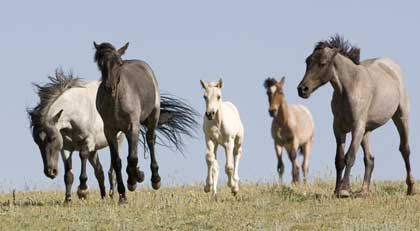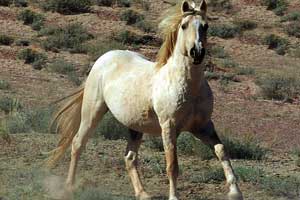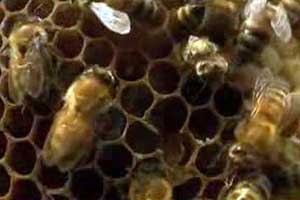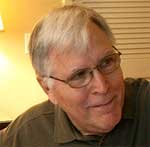[Bianculli here: This weekend, contributing writer Tom Brinkmoeller tracks down the executive producer of the long-running PBS series Nature, to explain the birds and the bees. Or, at least, the bees and the stallions...]

Run Like a Stallion, Sting Like a Bee -- As Presented on Public TV
Nature starts a new season on PBS this Sunday (8 p.m. ET; check local listings) with the third segment in the fascinating story of Rocky Mountain wild horses, "Cloud: Challenge of the Stallions." Naturalist-photographer Ginger Katherns has followed Cloud, a wild stallion, from its birth to its role as a powerful leader among this rare group of untamed horses.

Katherns' instincts in documenting, from the beginning, the life of what would become an extraordinary animal have resulted in a beautifully shot nature trilogy that lets viewers see places and witness events few people experience.
Otherwise-difficult access to places and events pretty accurately summarizes the role Nature has played since it started its run on public television in 1982. Natural-history programming was a virtually empty category in U.S. television at the time, said Nature Executive Producer Fred Kaufman in a recent interview.
He has been with the series since the start, and has led the effort since 1991. The BBC successfully had been producing high-quality natural-history shows for some time, and the new PBS series imported the British network's shows in its early days.
"There really wasn't a market in the U.S. for that type of show at the time," he said. "As a result, we paid sort of a wholesale price" to the BBC producers.
It wasn't too long before original Nature programs were being produced. The transition has been very successful. To date, the series has won 10 Emmys, three Peabody Awards, and received the Sierra Club's first-ever award to a television show. At 28 seasons, it's a successful long-distance runner, and its long-time hold on the 8 p.m. Sunday spot underlines its popularity. It remains a staple in many homes for intelligent, accessible family programming.
A key to its continued success is its ability to expand the original concept and adapt to changes in viewer sophistication and advances in technology.
"For the first 10 years, you would have been hard-pressed to find a person in any (Nature) scene," Kaufman said. Also, he added, all early shows also were exclusively shot on film. But the people who produce the footage now help tell important parts of the stories, and the transition to videotape -- and then to high definition -- were changes that made the series even better.

In 2007, a Nature episode, "Silence of the Bees," used a special camera that allows a dramatic slow-motion effect and the same endoscopic video technology used by surgeons to go inside bee colonies. The technology helped to better explain the phenomenon that has been devastating the world's bee population.
It also won the series a Peabody Award for the episode.
Kaufman's confidence in the production's singular excellence sank dramatically the night it aired, and winning awards was far from his thoughts. An hour before "Silence of the Bees" premiered, the hit CBS newsmagazine 60 Minutes aired an in-depth story on the same topic.

"My jaw dropped," he said when he saw the piece. "They did a great job."
He worried the Nature special would suffer from overexposure. That was not the case. Kaufman said a Peabody judge explained Nature was given the prize because it not only explained the issue as well as 60 Minutes, but also "because of the way we filmed the bees... that bumped it up a bit."
Kaufman oversees the production of 13 new episodes each year. In deciding which shows get produced, they follow a simple directive: "What haven't we done that we can do that the audience will enjoy?" Some ideas come from inside, while others are generated by a network of researchers and nature videographers that has grown over the years. A stretch of 18 months to three years can occur between the approval of an idea and its completion, he said.
This season's shows will take close looks at the first days of life for all kinds of animals ("Born Wild: The First Days of Life," Nov. 1); the efforts of some South African snake handlers to improve the image of s dangerous snake ("Black Mamba," Nov. 8), and the first year in the life of a female humpback whale ("Fellowship of the Whales," Nov. 15).
New episodes in early 2010 will focus on wolverines, the giant pythons that live in the Everglades, and confrontations between Yellowstone's bears and wolves.
--

Tom Brinkmoeller did some research and discovered a few PBS series have been on longer than Nature: Washington Week ('67); Sesame Street ('69); Masterpiece Theatre ('71); Great Performances ('72); Austin City Limits and Nova (both '74); Newshour ('75) -- all TV Worth Watching.